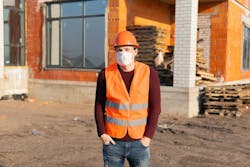New Study Finds Unchecked Construction Activity Could Triple Austin’s Coronavirus-Related Hospitalizations
Construction work has been deemed essential by the federal government, but a new study in Austin, Texas, found that keeping construction sites open could come at a cost. The study, commissioned by the city, found that keeping the job sites open while nearly all other businesses are closed could triple the number of coronavirus-related hospitalizations of the general population from 10,000 to 30,000. Workers would be even more at risk with a possible eightfold increase of hospitalizations, according to modeling by researchers at the University of Texas at Austin. However, the study also highlights the importance of workplace safety and virus-transmission mitigation on construction sites: Keeping only 25 percent of workers on site dramatically reduces the number of hospitalizations from 30,000 to just over 10,000.
A new analysis has quantified how construction activity during the coronavirus pandemic elevates health hazards for workers as well as members of the general public in Austin, Texas.
The study, commissioned by Austin Mayor Steve Adler, found that keeping the city’s jobsites open while nearly all other businesses are shut down could triple the number of coronavirus-related hospitalizations in the general population — from 10,000 to 30,000 — and raise construction workers’ risk of hospitalization eightfold by the middle of August.
The model from a team of researchers at the University of Texas at Austin is based on a scenario that assumes the surrounding community is under a highly strict shelter-in-place order (with around 90% of residents staying home) while construction work continues with no special safety precautions. It also assumes that construction jobsites have double the transmission risk of a typical workplace due to the "nature of construction work and/or the elevated concentration of construction workers at essential worksites."
